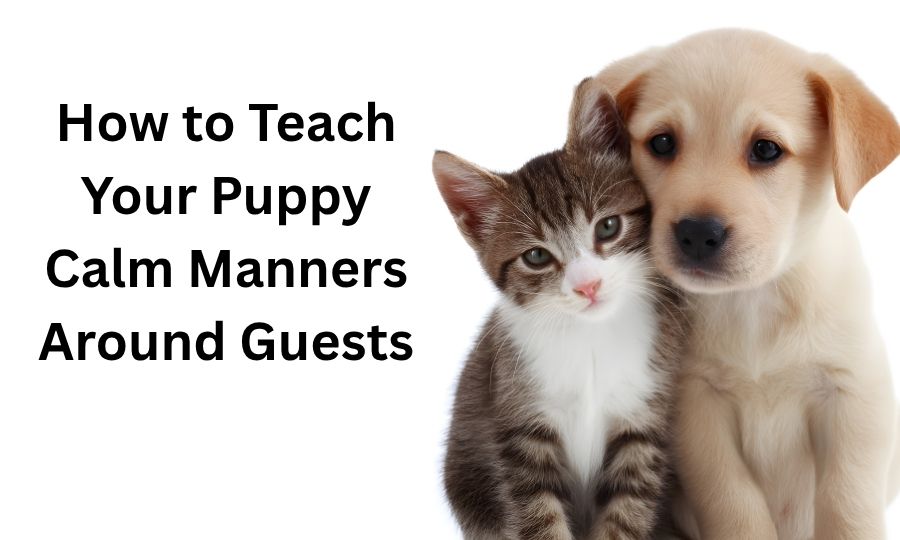Bringing home a new puppy is an exciting experience filled with joy and playfulness. However, when guests visit, that same excitement can quickly turn into chaos — with your puppy jumping, barking, or getting overly stimulated. Teaching your puppy calm manners around guests is an essential part of early socialization and obedience training. A well-mannered puppy not only makes a good impression but also learns to control their impulses in social situations.
Understanding Why Puppies Get Overexcited Around Guests
When guests arrive, puppies often experience a rush of energy and curiosity. The sound of the doorbell, new scents, and unfamiliar voices can trigger excitement and overstimulation. Puppies are naturally social animals, and their enthusiasm can lead to jumping, barking, or nipping. Recognizing that this behavior is not “bad” but simply a lack of impulse control helps owners approach training with patience rather than frustration. Understanding the root cause allows you to address excitement calmly and train your puppy to behave appropriately.
Setting the Foundation Before Guests Arrive
Before you can expect calm behavior when people visit, you must first teach your puppy basic obedience commands such as “sit,” “stay,” and “down.” These commands form the foundation of polite manners. Practice these commands daily in a quiet environment where there are no distractions. Once your puppy can follow them consistently, gradually introduce mild distractions like background noise or movement. This preparation helps your puppy understand how to stay calm even in stimulating environments.
Teaching the “Settle” Command at Home
One of the most effective ways to manage excitement is by teaching your puppy the “settle” command. This command teaches your puppy to relax on cue. Choose a calm environment and encourage your puppy to lie down or rest in a comfortable spot. Use a soft voice and reward calm behavior with gentle praise or affection. Over time, your puppy will associate the word “settle” with relaxation. This training can be incredibly useful when guests visit, helping your puppy understand that calm behavior earns attention and rewards.
Gradual Exposure to Visitors
Instead of introducing your puppy to a large group of guests at once, begin with one or two familiar people. Controlled exposure allows your puppy to adjust to new faces and smells without becoming overwhelmed. Ask your guests to remain calm and avoid making direct eye contact or sudden movements. Allow your puppy to approach them at their own pace. Gradual exposure helps your puppy build confidence and reduces anxiety or excessive excitement over time.
Creating a Calm Environment Before the Door Opens
The moments before a guest enters your home can be the most challenging for a young puppy. The sound of the doorbell often triggers a surge of excitement. To manage this, rehearse doorbell situations before any real visitors arrive. Practice having someone ring the bell while you guide your puppy into a calm position like “sit” or “stay.” Once your puppy remains calm, open the door and reward the behavior. This consistent practice helps your puppy learn that calmness, not chaos, is what gets your attention and praise.
Greeting Guests Politely
When it’s time for your puppy to meet your guests, focus on reinforcing calm greetings. Allow your puppy to approach only when they are sitting or standing quietly. If your puppy jumps or barks, ask your guests to turn away and ignore the behavior. Puppies quickly learn that only calm behavior leads to attention and affection. Keep initial interactions brief to avoid overstimulation. Over time, your puppy will begin to greet people politely without needing constant correction.
Managing Overexcitement During Visits
Even well-trained puppies can become overly excited during longer visits. When you notice signs of overstimulation such as heavy panting, zooming around, or barking excessively, calmly redirect your puppy to a quiet area. Providing a cozy bed or crate where your puppy can rest helps them relax and reset. Avoid yelling or scolding, as this can increase anxiety. Instead, give your puppy time to calm down before allowing them to rejoin the group. Consistently managing overstimulation teaches your puppy that calm behavior leads to positive outcomes.
Maintaining Consistency for Long-Term Success
Training a puppy to behave calmly around guests is not something that happens overnight. Consistency is the key to success. Everyone in your household should follow the same rules and reward system. If one person allows jumping or loud play while another enforces calm behavior, your puppy will become confused. Keep training sessions short but frequent, and continue reinforcing calm greetings even after your puppy becomes more mature. With patience and regular practice, your puppy will learn that good manners are always expected when guests are present.
Final Thoughts
Teaching your puppy calm manners around guests is a rewarding process that strengthens your bond and helps your puppy grow into a confident, well-behaved companion. By understanding your puppy’s excitement, preparing through obedience training, and maintaining consistency, you can create a peaceful and welcoming environment for everyone — both humans and dogs alike.
Over time, your puppy will not only stop jumping and barking when visitors arrive but will also learn that calmness brings attention, affection, and happiness. With patience and persistence, your home can become a place where good manners come naturally to your beloved puppy.

